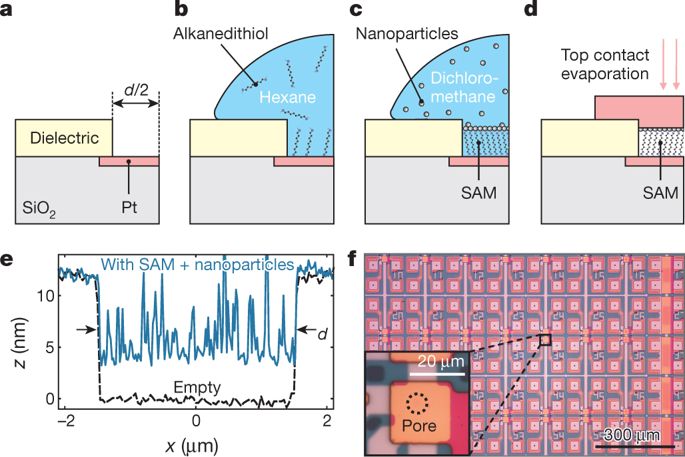Our official English website, www.x-mol.net, welcomes your feedback! (Note: you will need to create a separate account there.)
Metallic nanoparticle contacts for high-yield, ambient-stable molecular-monolayer devices
Nature ( IF 64.8 ) Pub Date : 2018-07-01 , DOI: 10.1038/s41586-018-0275-z Gabriel Puebla-Hellmann , Koushik Venkatesan , Marcel Mayor , Emanuel Lörtscher
Nature ( IF 64.8 ) Pub Date : 2018-07-01 , DOI: 10.1038/s41586-018-0275-z Gabriel Puebla-Hellmann , Koushik Venkatesan , Marcel Mayor , Emanuel Lörtscher

|
Accessing the intrinsic functionality of molecules for electronic applications1–3, light emission4 or sensing5 requires reliable electrical contacts to those molecules. A self-assembled monolayer (SAM) sandwich architecture6 is advantageous for technological applications, but requires a non-destructive, top-contact fabrication method. Various approaches ranging from direct metal evaporation6 over poly(3,4-ethylenedioxythiophene) polystyrene sulfonate7 (PEDOT:PSS) or graphene8 interlayers to metal transfer printing9 have been proposed. Nevertheless, it has not yet been possible to fabricate SAM-based devices without compromising film integrity, intrinsic functionality or mass-fabrication compatibility. Here we develop a top-contact approach to SAM-based devices that simultaneously addresses all these issues, by exploiting the fact that a metallic nanoparticle can provide a reliable electrical contact to individual molecules10. Our fabrication route involves first the conformal and non-destructive deposition of a layer of metallic nanoparticles directly onto the SAM (itself laterally constrained within circular pores in a dielectric matrix, with diameters ranging from 60 nanometres to 70 micrometres), and then the reinforcement of this top contact by direct metal evaporation. This approach enables the fabrication of thousands of identical, ambient-stable metal–molecule–metal devices. Systematic variation of the composition of the SAM demonstrates that the intrinsic molecular properties are not affected by the nanoparticle layer and subsequent top metallization. Our concept is generic to densely packed layers of molecules equipped with two anchor groups, and provides a route to the large-scale integration of molecular compounds into solid-state devices that can be scaled down to the single-molecule level.A top-contacting method for the fabrication of molecular devices uses metallic nanoparticles to electrically contact self-assembled monolayers, enabling the preparation of thousands of identical, ambient-stable metal–molecule–metal devices.
中文翻译:

用于高产率、环境稳定的分子单层器件的金属纳米颗粒触点
为电子应用 1-3、光发射 4 或传感 5 访问分子的内在功能需要与这些分子可靠的电接触。自组装单层 (SAM) 夹层结构 6 有利于技术应用,但需要非破坏性的顶部接触制造方法。已经提出了从在聚(3,4-亚乙基二氧噻吩)聚苯乙烯磺酸盐 7(PEDOT:PSS)或石墨烯 8 夹层上直接金属蒸发 6 到金属转移印刷 9 的各种方法。然而,在不影响薄膜完整性、内在功能或大规模制造兼容性的情况下,制造基于 SAM 的设备尚不可能。在这里,我们为基于 SAM 的设备开发了一种顶部接触方法,可以同时解决所有这些问题,通过利用金属纳米颗粒可以为单个分子提供可靠的电接触这一事实。我们的制造路线首先包括将一层金属纳米颗粒直接保形和非破坏性沉积到 SAM(本身横向限制在介电基质中的圆形孔内,直径范围从 60 纳米到 70 微米),然后增强这种顶部接触通过直接金属蒸发。这种方法可以制造数千个相同的、环境稳定的金属-分子-金属器件。SAM 组成的系统变化表明,本征分子特性不受纳米颗粒层和随后的顶部金属化的影响。
更新日期:2018-07-01
中文翻译:

用于高产率、环境稳定的分子单层器件的金属纳米颗粒触点
为电子应用 1-3、光发射 4 或传感 5 访问分子的内在功能需要与这些分子可靠的电接触。自组装单层 (SAM) 夹层结构 6 有利于技术应用,但需要非破坏性的顶部接触制造方法。已经提出了从在聚(3,4-亚乙基二氧噻吩)聚苯乙烯磺酸盐 7(PEDOT:PSS)或石墨烯 8 夹层上直接金属蒸发 6 到金属转移印刷 9 的各种方法。然而,在不影响薄膜完整性、内在功能或大规模制造兼容性的情况下,制造基于 SAM 的设备尚不可能。在这里,我们为基于 SAM 的设备开发了一种顶部接触方法,可以同时解决所有这些问题,通过利用金属纳米颗粒可以为单个分子提供可靠的电接触这一事实。我们的制造路线首先包括将一层金属纳米颗粒直接保形和非破坏性沉积到 SAM(本身横向限制在介电基质中的圆形孔内,直径范围从 60 纳米到 70 微米),然后增强这种顶部接触通过直接金属蒸发。这种方法可以制造数千个相同的、环境稳定的金属-分子-金属器件。SAM 组成的系统变化表明,本征分子特性不受纳米颗粒层和随后的顶部金属化的影响。



























 京公网安备 11010802027423号
京公网安备 11010802027423号